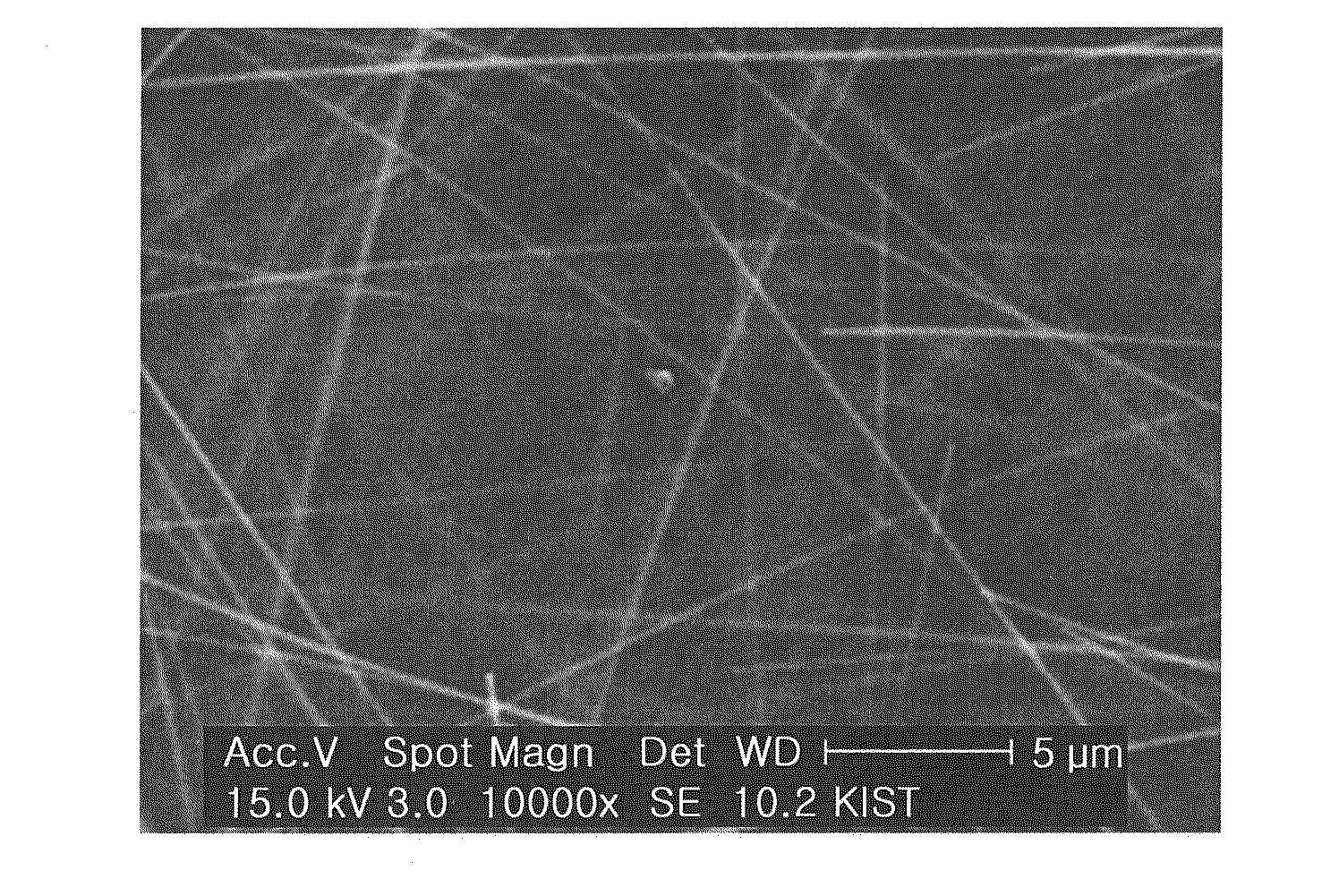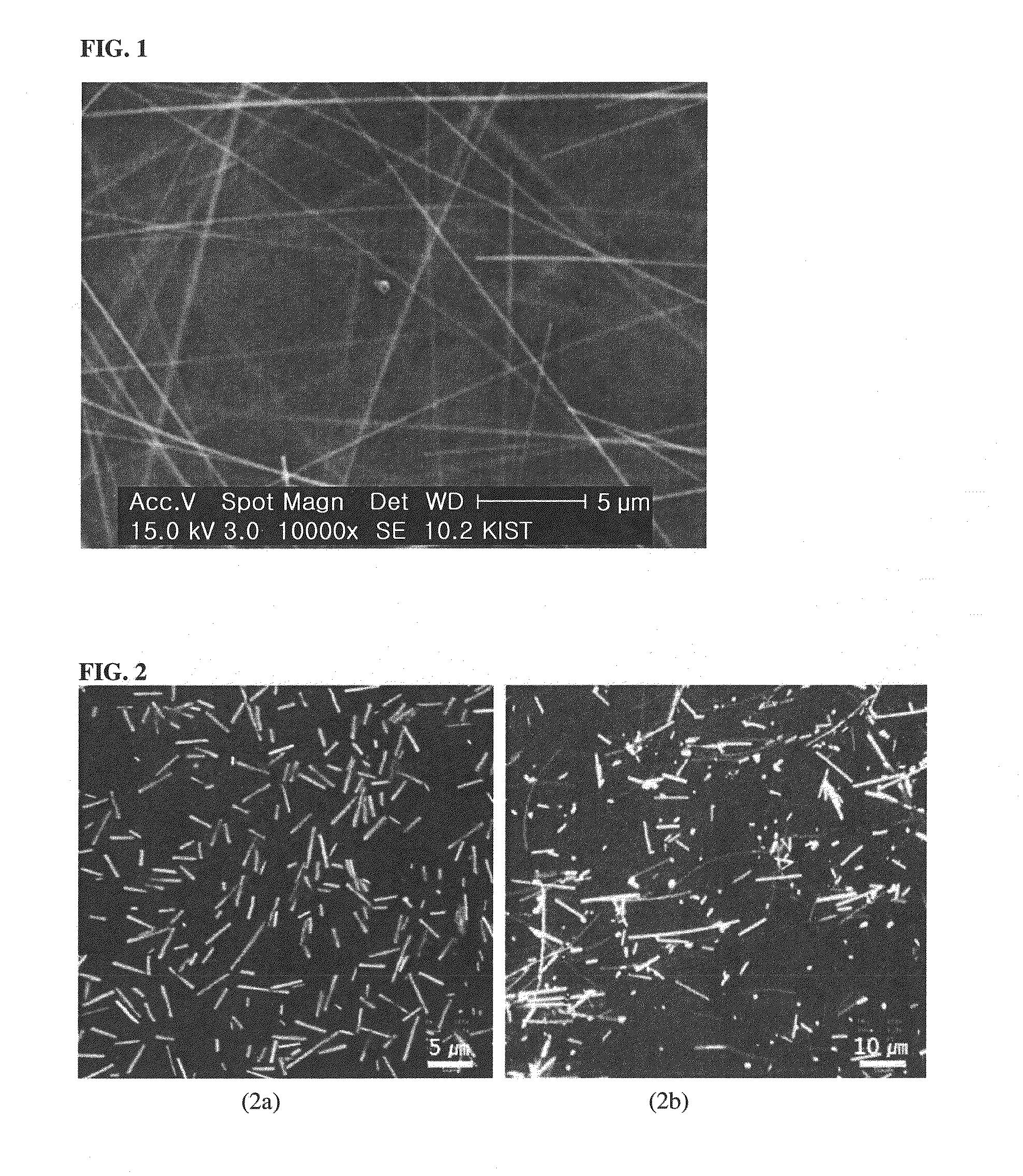Metal nanowires with high linearity, method for producing the metal nanowires and transparent conductive film including the metal nanowires
a technology of metal nanowires and linearity, applied in the direction of nanostructure manufacturing, non-conductive materials with dispersed conductive materials, nuclear engineering, etc., can solve the problems of high production cost of ito thin films, difficult to form ito thin films on highly flexible plastic substrates and films, and deterioration of their characteristics, etc., to achieve high linearity, low sheet resistance, and high transmittance
- Summary
- Abstract
- Description
- Claims
- Application Information
AI Technical Summary
Benefits of technology
Problems solved by technology
Method used
Image
Examples
example 1
[0070]5-8 g of polyvinylpyrrolidone (PVP K-90) having a molecular weight between 900,000 and 1,500,000 was added to 200 ml of ethylene glycol (EG) in a round-bottom flask and slowly stirred in an oil bath. After the mixture was heated to a temperature of 170° C., 0.01-0.2 g of cetyltrimethylammonium bromide (CTBA) or potassium bromide (KBr) as a reducing agent was added thereto and was allowed to react with stirring for 40 min. To the reaction solution was added 0.5-1 g of silver chloride. The reaction was allowed to proceed. After addition of 1-3 g of silver nitrate, the reaction was allowed to proceed to produce Ag nanowires with high linearity. The Ag nanowires were found to have a diameter of 30 nm or less and a length of 40 μm or more.
[0071]FIG. 1 is a scanning electron microscopy (SEM) image of the Ag nanowires.
example 2
[0072]Two kinds of Ag nanowires were produced in the same manner as in Example 1, except that PVP having a molecular weight between 500,000 and 800,000 and PVP K-120 having a molecular weight between 2,000,000 and 3,000,000 were separately used. FIG. 2 shows scanning electron microscopy (SEM) images of the Ag nanowires produced using the PVP (2a) and the Ag nanowires produced using the PVP K-120 (2b). The SEM images confirm that it is more difficult to increase the diameter of the Ag nanowires when the polyvinylpyrrolidone having a lower molecular weight is used.
example 3
[0073]Ag nanowires were produced in the same manner as in Example 1, except that the cetyltrimethylammonium bromide (CTBA) or potassium bromide (KBr) was added in different amounts of 0.01-0.5 g.
[0074]FIG. 3 shows scanning electron microscopy (SEM) images of the Ag nanowires. Spherical Ag particles are observed, together with the Ag nanowires, in the SEM image (3b).
PUM
| Property | Measurement | Unit |
|---|---|---|
| Temperature | aaaaa | aaaaa |
| Temperature | aaaaa | aaaaa |
| Temperature | aaaaa | aaaaa |
Abstract
Description
Claims
Application Information
 Login to View More
Login to View More - R&D
- Intellectual Property
- Life Sciences
- Materials
- Tech Scout
- Unparalleled Data Quality
- Higher Quality Content
- 60% Fewer Hallucinations
Browse by: Latest US Patents, China's latest patents, Technical Efficacy Thesaurus, Application Domain, Technology Topic, Popular Technical Reports.
© 2025 PatSnap. All rights reserved.Legal|Privacy policy|Modern Slavery Act Transparency Statement|Sitemap|About US| Contact US: help@patsnap.com



